IN THIS ISSUE
- Exploring Chickasawhatchee WMA
- Asian spider weaves way into Georgia
- Native tree combines beauty and bounty
- Rare plant rebounds at Lower Broad River
 Limpkin at Chickasawhatchee WMA (James Malphrus)
By JAMES MALPHRUS
It was a Wednesday and we wanted to ease the stress of the work week with a little catch-and-release action: We were going fishing. My wife and I had been riding from pond to pond for a half-hour, striking off our usual haunts because “Access to that one is too muddy,” “Lily pads are covering the pond,” “We’ve barely caught any fish in that one.” It was time to call an audible.
In recent months, we had spent most of our Sundays on public lands. As a precursor to such romps, we usually talked about where we were going the week before, giving us time to familiarize ourselves with the location.
We had talked about visiting Chickasawhatchee Wildlife Management Area. But we weren’t planning on it this soon.
It started with something like, “I’m sure there’s a pond out there, wanna try it?” Her sarcastic agreement was license enough to head out of town. She didn’t notice right away, but as I encouraged her to look up maps of the WMA, she realized I was serious. By then we were leaving Albany and racing the sunset. …
Join James Malphrus for adventure at 19,700-acre Chickasawhatchee WMA, part of the massive Chickasawhatchee Swamp. The Albany resident blogs about visiting the southwest Georgia WMA “on a whim,” as well as he and his wife Rebecca’s return with more time to explore. Also see his other public-land journals, including Horse Creek and Crockford-Pigeon Mountain WMAs, at jcma.today.
Top
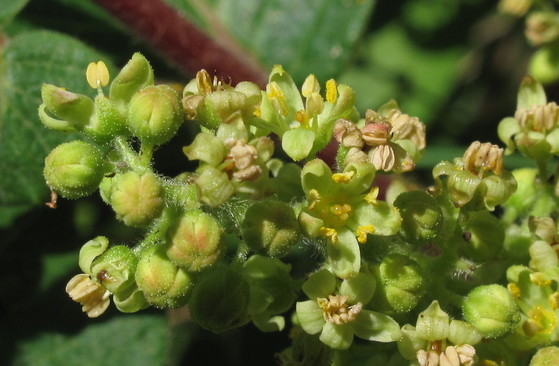 By BETH QUILLIAN
On a woodland knoll overlooking Anthony Shoals on the Broad River, something rare has been spreading underground.
It’s a warm summer morning and Dr. J. Mincy Moffett Jr., a botanist with DNR’s Wildlife Conservation Section, is pointing out a plant that makes this knoll on Lower Broad River Wildlife Management Area unique – dwarf sumac.
Once known in five states, this endangered species is now found only in three: Georgia, North Carolina and Virginia. And in Georgia, dwarf sumac naturally occurs in just two places.
One is Lower Broad River WMA near Elberton, where restoration of the plant and its woodland habitat is based on another feature of dwarf sumac: its ability to survive underground, with few stems visible. …
Learn about dwarf sumac and its habitat in this blog post and the video below.
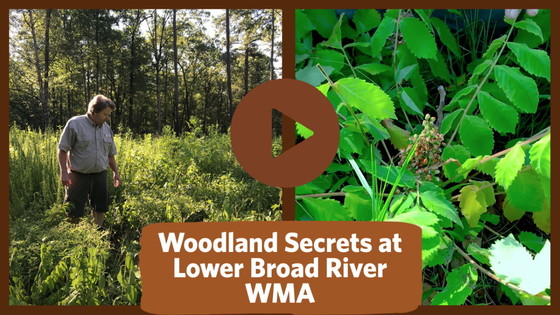 Beth Quillian works in Public Affairs at the DNR Wildlife Resources Division.
Top
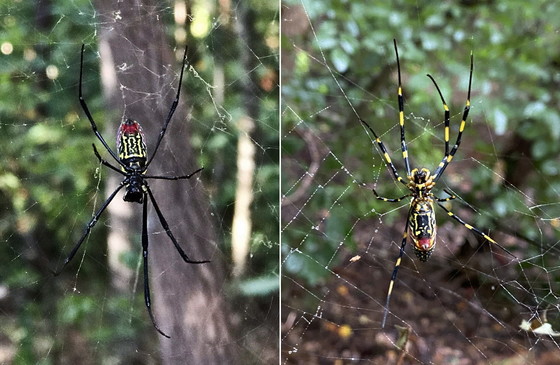 Joro spiders at Elachee Nature Science Center in Gainesville (Elachee Nature Science Center)
Just in time for Halloween, more headlines about a big, new spider in Georgia.
Meet Trichonephila clavata, aka the Joro spider. Females can grow 4 inches long. Joro webs are also super-sized, sometimes reaching from powerlines to the ground.
These arachnids from East Asia were first documented in North America in 2014 near Colbert. Likely introduced to this continent via shipped materials, the species has since been found across northeast Georgia and even into North Carolina.
It’s not known yet what impact they might be having on native spiders, including large species such as banana spiders and the more common writing spiders, which many call garden spiders.
But the University of North Georgia’s Dr. Mattias Johansson, an assistant biology professor studying Joro spiders in Georgia, believes it’s possible the newcomers are outcompeting their native neighbors and affecting the larger insect community.
So far only anecdotes suggest that dynamic. But “there are so many (Joro spiders) and they’re so big," Johansson said, "they must be processing a fair bit of prey to get that size and become that numerous.”
The number and spread also suggest they are here to stay. While that might seem like scary news, Johansson said that even though the species is venomous – as all spiders are – it is not considered dangerous and is “actually pretty sedentary.”
As for the name, that's a different story. Joro is derived from Jorōgumo. According to Japanese mythology, Jorōgumos are large spiders that can supernaturally appear as a beautiful woman to snare men, which they kill and devour. The name for Joros in Korea (mudang gumi) is less horrifying: It means shaman or fortune-teller.
SEEN ONE?
The Times in Gainesville is collecting reports of Joro spiders and providing them to Dr. Mattias Johansson. Sightings can be logged on this Google map through Nov. 2.
IDENTIFYING JOROS
- The only native spiders that Joro spiders would be easily confused with are writing and the more scarce banana spiders. Joros tend to be larger than both.
- Coloration between the species can be similar but Joros tend to have more blue on their body.
- Writing spiders sit in their webs with their front and back pairs of legs together, forming an X; Joros don’t.
- Banana spiders have legs that appear almost furry, particularly at some joints. Joro legs don’t look furry and they are thinner.
- Most Joro webs are three-dimensional, with a central orb plus two irregular layers behind it. They do not have the zig-zag pattern of writing spider webs.
- If the lighting is right, Joro webs have a golden hue (although banana spiders, which are part of the same genus, also create similar-colored webbing).
Top
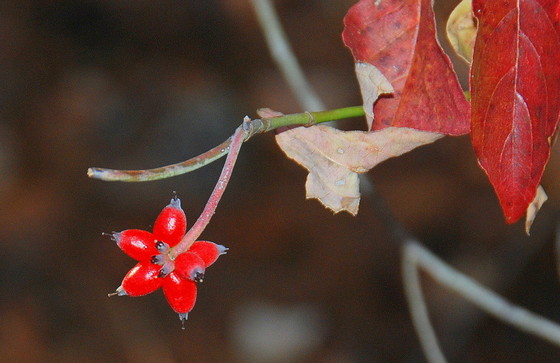 Fall favorite: flowering dogwood berries (Terry W. Johnson)
By TERRY W. JOHNSON
What would you say if I told you there is a native tree that produces a bounty of colorful berries relished by scores of songbirds and other backyard wildlife? What if I added that this tree is as beautiful in a yard as it is in Georgia's woodlands?
Chances are you would tell me that there is no such tree.
Well, fortunately there is. And it’s a familiar tree: the flowering dogwood.
But don't feel bad if you thought such a tree was a figment of my imagination. Although the beauty of flowering dogwoods is undisputed, their value as a wildlife food plant is underappreciated. …
Read the rest of Terry’s column to learn why dogwoods are a wildlife favorite.
Terry W. Johnson is a retired DNR program manager and executive director of TERN, the Wildlife Conservation Section’s friends group. Check out past columns, his Backyard Wildlife Connection blog and his book “A Journey of Discovery: Monroe County Outdoors.” His columns are also featured on DNR’s blog, under the Conservation tab. Permission is required to reprint Terry’s columns.
Top
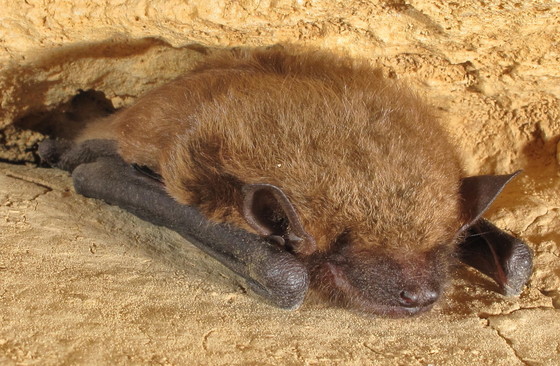 Big brown bat in a Walker County cave (Alan Cressler)
This Halloween, help the holiday’s iconic creature by contributing to bat conservation. Visit gooutdoorsgeorgia.com, click “Licenses and Permits” (if you don’t have a customer account), then choose "Purchase a License" to view options for donating to the Georgia Nongame Wildlife Conservation Fund, created by law to conserve bats and other native wildlife not legally fished for, hunted or collected.
The U.S. Fish and Wildlife Service wants to downlist red-cockaded woodpeckers from endangered to threatened under the Endangered Species Act. According to the agency’s proposal, conservation efforts have improved populations and habitat to the point the birds are no longer in danger of extinction.
Five red-cockaded woodpeckers were moved from Apalachicola National Forest to River Creek, the Rolf and Alexandra Kauka Wildlife Management Area near Thomasville this month. Combined with monitoring and habitat management, translocations are helping restore the species at River Creek, where the number of red-cockaded family groups has grown from none to six since 2017.
Add eastern black rails to the list of federally threatened species. These secretive birds dubbed “feathered mice” have suffered steep declines and increasing habitat loss, as evidenced by south Georgia surveys in 2017 and 2018 that failed to detect any black rails.
Top
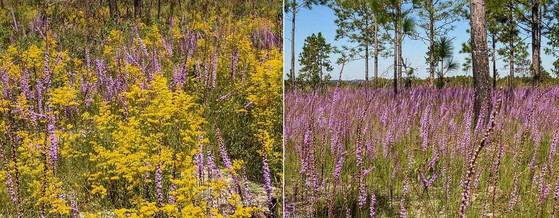 "Super bloom" at Sandhills West WMA (DNR)
Middle Georgia might not come to mind when thinking about fall color. But a DNR project with the state Department of Transportation and the Georgia Forestry Commission to thin and burn nearly 500 acres on Sandhills West Wildlife Management Area produced a “super bloom” of wildflowers and grasses in September.
Leaf peepers can use Leaf Watch 2020 to explore trips and track fall colors across the Georgia. The planner features trails, hiking tips, cabins and campsites. (Also check out this look at “secret” state parks for fall color.)
Remember Artax, the manatee rescued with her calf on the Savannah River last fall? Artax made tracks – or wakes – this month by swimming from Savannah where she spent the summer to Cape Canaveral, Fla., in only 12 days (and covering the 100 miles to the Florida line in less than three days). P.S.: After the rescue in November, SeaWorld had rehabilitated Artax and her calf, fitted the mom with a transmitter, and released the two in Florida.
Not fast enough for you? Then how about the bar-tailed godwit that flew nonstop for 11 days and 7,500 miles from Alaska to New Zealand. Even for a bird “built like a jet fighter,” the flight documented by sightings of the banded male blasted the previous record: 7,145 miles in nine days, also by a bar-tailed godwit.
Top
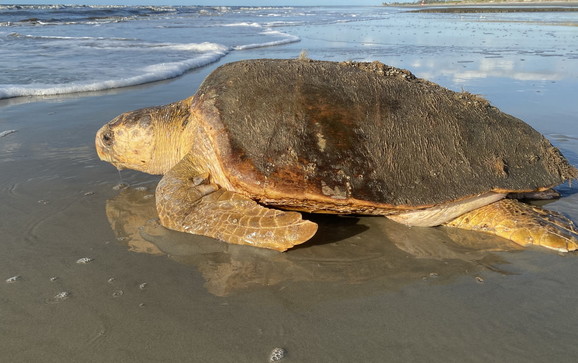 Loggerhead returning to ocean after nesting (Mark Dodd/DNR)
Loggerhead sea turtles logged another solid nesting season in the state, with 2,783 nests and 170,000-plus hatchlings documented by the Georgia Sea Turtle Cooperative. DNR Sea Turtle Program Coordinator Mark Dodd said the above-average season furthered a trend of loggerhead nesting increasing at about 3.9 percent a year. Instead of a wrap-up meeting, co-op members compiled this video.
To advance life-sciences education during the pandemic, DNR expanded eligibility for its Conservation Teacher of the Year grant. The $1,000 is now offered to a kindergarten through fifth-grade public or private school teacher in Georgia who demonstrates exceptional energy and innovation in teaching life sciences.
Hairy-peduncled beaksedge, a plant petitioned for federal listing, had not been documented in Georgia for 25 years until Wildlife Conservation Section staff and a Nature Conservancy volunteer found the blackwater stream-bank species at three of six sites checked. The findings will be help assess the plant’s conservation status.
With sea-level rise threatening saltmarsh sparrows, the Atlantic Coast Joint Venture, a partnership that includes DNR, has created a range-wide conservation plan. The goal: Create and conserve enough high-quality habitat to sustain a population of 25,000 saltmarsh sparrows long-term.
Top
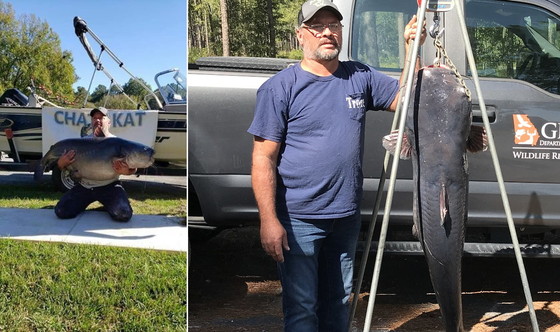 Angler Tim Trone with new state-record blue catfish (special to DNR)
Move over, IBM, we have another Big Blue. The 110-pound, 6-ounce blue catfish that angler Tim Trone pulled from the upper end of Lake Walter F. George on Oct. 17 beat the previous state record by more than 17 pounds.
Responding to a report of Japanese mystery snails at Stone Mountain Park, Wildlife Conservation Section staff collected more than 80 adult snails from the park’s lake. Native to southeast Asia and introduced to the U.S. in the late 1890s, this invasive mollusk has spread throughout the nation.
More than 500 students have joined a Charlie Elliott Wildlife Center virtual field trip so far this month. The outreach geared to making outdoor education more available during the pandemic has drawn positive reviews from teachers and youth.
According to Georgia Wild readers responding to the annual e-news survey:
- Nine out of 10 had told someone at least once about an item in the newsletter.
- 93 percent agreed that Georgia Wild informs them about conservation and in an easy-to-understand way.
- 80 percent had been spurred to learn more about a wildlife species or issue, and 21 percent to financially support wildlife conservation in Georgia.
- More than half– 60 percent – did not know until they subscribed that DNR's Wildlife Conservation Section depends largely on fundraisers, grants and contributions. Now, thankfully, they do.
The 10 survey takers drawn for a DNR cap ranged in residence from Rocky Face, Ga., to Winter Springs, Fla., and Marcellus – yes, you read that right – Mich.
Top
 DNR gopher tortoise crew scope a burrow at Ceylon WMA. (Mac Stone)
Gopher tortoise surveys at the new Ceylon Wildlife Management Area indicate the area has nearly 3,000 tortoises. Survey crew members also found other rare species on the Camden County site, including gopher frogs, hooded pitcherplants and gopher tortoise robber flies.
Going virtual went well for the Georgia Prescribed Fire Council’s annual meeting. Attendance topped 570 people, with participants from 22 states and four other countries – France, Portugal, Spain and India.
Florida is taking another approach to restricting who can buy, own or sell pythons, tegus and other reptiles that pose problems as invasive species. While a 2020 law tackling the issue has been ruled unconstitutional, the state’s Fish and Wildlife Conservation Commission is proposing rules that will set similar limits.
The Bluffs of St. Teresa acquired by the Florida Department of Environmental Protection and The Nature Conservancy adds 17,088 acres to a protected landscape exceeding 1 million acres in Florida's Big Bend region. The tract completes a stretch of conservation lands reaching from St. Marks National Wildlife Refuge to Apalachicola National Forest.
Monarchs across Georgia's native plant sale is Nov. 1 at Grant Park Farmers Market in Atlanta. The fundraiser supports work by the Environmental Education Alliance of Georgia committee to study monarchs and restore butterfly habitats.
Top
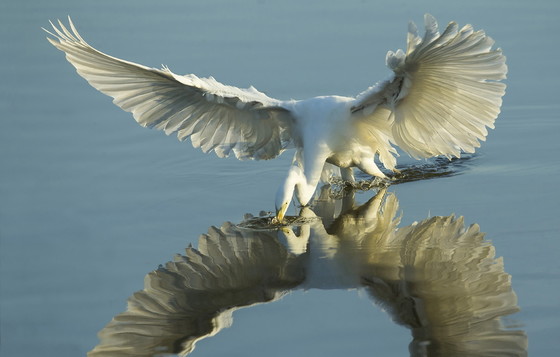 Great egret foraging at Altamaha WMA (Ty Ivey/Georgia Nature Photographers Association)
A really big day it was, as more than 31,000 birders from 167 countries reported 7,036 species on Oct. 17, the October Big Day led by eBird. With fall migration continuing, keep the fun going by visiting Georgia Birding & Wildlife Trails for viewing tips and hotspots, including the updated Colonial Coast Birding Trail.
Georgia Conservancy will hold its annual ecoBenefête online. The Nov. 19 event benefiting the nonprofit celebrates conservation and honors advocates, including this year's distinguished conservationist and longleaf award winners.
Names in the news: Wildlife Conservation Section’s Dr. J. Mincy Moffett Jr. has been named Volunteer of the Year for the Georgia Recreation and Park Association’s District 7. Moffett was recognized for installing, maintaining and promoting a Connect to Protect garden at Veterans Park in Oconee County. Edward Hunter Jr. is the new forest supervisor of the Chattahoochee-Oconee National Forests. Hunter had served as acting supervisor of the 867,000 acres of national forest since April. Georgia Conservancy trustees appointed Katherine Moore as president. Moore, previously the organization’s vice president of programs and sustainable growth director, succeeds Bart Gobeil. Glynn Academy 11th-grader Shelby Williams won the DNR Virtual CoastFest 2020 Art Contest. Her colored-pencil drawing of a red drum will be featured on the CoastFest 2021 T-shirt. The comic strip Mark Trail, created and drawn primarily by the late Georgians Ed Dodd and Jack Elrod Jr., has a new artist and a makeover. Jules Rivera says she plans to “bring back science, color and life while preserving the legacy of cute, pop art and loving nature enough to punch dudes in the face about it."
Correction: A news brief about Argentine black and white tegus in the September issue misidentified the U.S. Geological Survey.
WHAT YOU MISSED …
In the previous Georgia Wild:
- Wildlife trail upgrades
- Rare find for rare mussels
- Add fall color to your yard
Top
"DNR expands eligibility for Conservation Teacher grant," WLHR-FM (92.1, Lavonia), and others including WCHM-FM (94.3, Clarkesville)
"Explore wildlife with new Georgia & Wildlife Trails site," WRDW-TV (Chs. 12, 26, Augusta). Also: Savannah Business Journal, Chattanoogan.com, Albany Herald, The Chatsworth Times.
"Another right whale entangled; Maine proposes risk reductions," National Fisherman. Also: "No right whales in Bay of Fundy" (Maine Public Radio), "Seismic testing for oil halted off Georgia coast" (The Augusta Chronicle), "Lobstermen say documents show ‘catastrophic impact’ of whale protections" (Bangor Daily News, Maine), "Ropeless fishing systems promising for fishermen, whales" (Pew).
"Hunters, look out for giant Argentine lizards in woods," Georgia Outdoor News. Also: WALB-TV (Ch. 10, Albany).
"Trump environmental rollback spurs mining near Okefenokee," Associated Press
(audio) "Study: Most of plastic found in seabird stomachs was recyclable," WBUR-FM (90.9, Boston)
(video) "Seven arrested in wildlife trafficking investigation in Fla.," WCJB-TV (Ch. 20, Gainesville, Fla.)
"Biologists find bird that's male and female," ScienceAlert
"Acorns crucial for wildlife survival in winter," The Atlanta Journal-Constitution
"S.C. law signed to protect reptiles, amphibians against illegal trading," WCIV-TV (Ch. 4, Mount Pleasant, S.C.)
"Harvest of horseshoe crabs for blood challenged at S.C. refuge," Southern Environmental Law Center
"New climate maps show transformed U.S.," ProPublica
"Mark Trail strip passing torch," The (Gainesville) Times
"How diabolical ironclad beetles can survive being run over by a car," CBS News
Top
 "Georgia Sea Turtle Cooperative 2020," the co-op's wrap-up meeting for the sea turtle nesting season, DNR
(audio) "Reintroducing Fire into Long-unburned Pine Forests," Friends of Fire podcast including DNR's Shan Cammack, Southern Fire Exchange
"Talking Nature Tuesday: Owls," DNR
CoastFest 2020 video archives, including "All Aboard the R/V Anna" and "Fishing Basics 101," DNR
(audio) "How Indigenous Burning Practices Could Prevent Wildfires," Science Friday
"Hey, Whaddaya Know? Garter Snakes," DNR
"What Is a 'Birder?'" North Carolina Birding Trail
"VB 1000," (profile of the heavy crane that will be used to remove the M/V Golden Ray in St. Simons Sound), Unified Command
CREDITS
Masthead: Joro spider (Jeremy-Howell/UGA)
Top
|